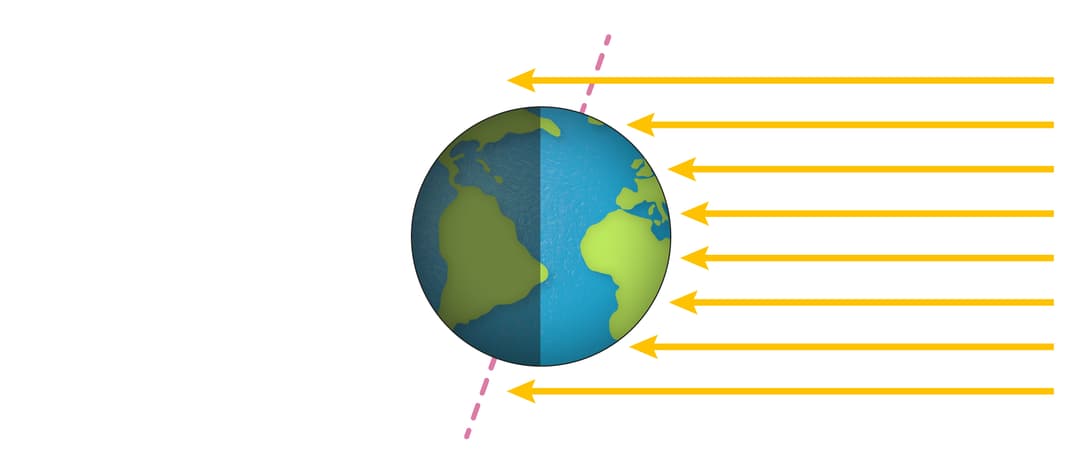Myths about teaching can hold you back
- Year 7
Earth's tilt
I can explain why it is winter in the southern hemisphere when it is summer in the northern hemisphere.
- Year 7
Earth's tilt
I can explain why it is winter in the southern hemisphere when it is summer in the northern hemisphere.
These resources will be removed by end of Summer Term 2025.
Switch to our new teaching resources now - designed by teachers and leading subject experts, and tested in classrooms.
These resources were created for remote use during the pandemic and are not designed for classroom teaching.
Lesson details
Key learning points
- In summer there are more daylight hours, compared to winter, the Sun appears higher in the sky and it is warmer.
- When it is summer in northern hemisphere countries it is winter in southern hemisphere countries.
- Earth spins on an axis that is tilted at an angle of 23.5 degrees.
- In June, the northern hemisphere is tilted towards the Sun, so has summer.
- In June, the southern hemisphere is tilted away from the Sun, so has winter.
Keywords
Summer - Summer is the warmest season, when the Sun is highest in the sky and there are more hours of daylight.
Winter - Winter is the coldest season, when the Sun is lowest in the sky and there are fewer hours of daylight.
Hemisphere - A hemisphere is half a sphere.
Axis - The axis of a spinning object is the imaginary line around which it spins.
Tilt - Something is tilted if it is at an angle to the horizontal or vertical.
Common misconception
Earth moves closer to the Sun in the summer and further away in the winter.
Remind students that Earth's orbit is nearly a perfect circle with the Sun at the centre so Earth's distance to the Sun does not significantly change over a year, and also that not everywhere on Earth has a warmer season at the same time, or at all.
To help you plan your year 7 science lesson on: Earth's tilt, download all teaching resources for free and adapt to suit your pupils' needs...
To help you plan your year 7 science lesson on: Earth's tilt, download all teaching resources for free and adapt to suit your pupils' needs.
The starter quiz will activate and check your pupils' prior knowledge, with versions available both with and without answers in PDF format.
We use learning cycles to break down learning into key concepts or ideas linked to the learning outcome. Each learning cycle features explanations with checks for understanding and practice tasks with feedback. All of this is found in our slide decks, ready for you to download and edit. The practice tasks are also available as printable worksheets and some lessons have additional materials with extra material you might need for teaching the lesson.
The assessment exit quiz will test your pupils' understanding of the key learning points.
Our video is a tool for planning, showing how other teachers might teach the lesson, offering helpful tips, modelled explanations and inspiration for your own delivery in the classroom. Plus, you can set it as homework or revision for pupils and keep their learning on track by sharing an online pupil version of this lesson.
Explore more key stage 3 science lessons from the Our solar system and beyond unit, dive into the full secondary science curriculum, or learn more about lesson planning.

Equipment
Licence
Prior knowledge starter quiz
6 Questions
Q1.Which of these statements correctly describes a year?
Q2.Which of these statements does not show that Earth is a sphere?
Q3.Put the seasons into the correct order that they arrive in the northern hemisphere, starting with the one in January.
Q4.If you continuously travel on Earth in one direction, you will end up back where you started. What does this provide evidence for?
Q5.Reptiles use the Sun's light to warm up. What is the best time of day to get warm from sunlight?
Q6.A pupil takes a timelapse video of the stars in the night sky over several hours. What path do the stars seem to follow?
Assessment exit quiz
6 Questions
Q1.Which two of these statements are features of summer?
Q2.Earth spins on an axis that is at an angle of 23.5 degrees.
Q3.In June, it is summer in northern hemisphere countries like the UK. What season will it be in June in southern hemisphere countries like Chile, South African and New Zealand?
Q4.Which statement about June in the northern hemisphere is correct?
Q5.Which statement about June in the southern hemisphere is correct?
Q6.The picture shows Earth in June. Which three statements explain why it is summer in northern countries like the UK, but winter in southern countries like South Africa and Chile?



